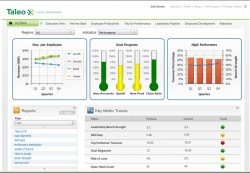 Taleo officially joins the ranks of the repositioned today, declaring that its “next era of talent management” shall henceforth be known as “Talent Intelligence.”
Taleo officially joins the ranks of the repositioned today, declaring that its “next era of talent management” shall henceforth be known as “Talent Intelligence.”
In a word, what that means is analytics, or, if you prefer, metrics.
What’s so special about that, you may be asking, that it merits more than a mention? If it was merely a rebranding of talent management (and it is partly that), it probably wouldn’t. However, it is part of an industry-wide effort by vendors to educate employers, especially those with a “C” as the first letter of their title, to the value that lies within their HR systems.
Where the first wave of TM products were positioned as electronic assistants, providing easy storage and retrieval of employee records, products have now matured so far that they can be valuable tools in managing the business.
As Taleo’s VP of Product Marketing Ashley Stirrup said last week, companies spend billions ($100 billion according to the Taleo demo) buying and operating their ERPs, CRMs, and SCMs. When it comes to people management, Taleo says the spend is 2 percent of that.
With the pie chart showing those numbers up on our WebEx screen, Stirrup observed, “It really highlights how little companies know about their employees.”
One reason for that is that except in a few areas — sales comes to mind immediately — quantifying performance is difficult. Another reason is that it has only been the last few years that the software systems have become sufficiently sophisticated and integrated to allow managers to extract relevant employee information and link it to operational and production data.
HR hasn’t done enough to promote these capabilities and show the CFOs and CEOs how to use the power of these systems to advise their business decisions. For that matter, line managers and directors barely know about this. In fact, there’s a better than even money chance that most HR professionals themselves don’t know how to use their systems for business intelligence.
So it’s going to be up to the vendors to do some educating if they want to move that 2 percent to 3 percent.
 Stirrup and Duncan Egan, Taleo’s senior director of marketing/Business Edition, offered some examples of how to use Taleo Insight, the analytics product the company has available for users of its Business Edition.
Stirrup and Duncan Egan, Taleo’s senior director of marketing/Business Edition, offered some examples of how to use Taleo Insight, the analytics product the company has available for users of its Business Edition.
A recruiter could pull the last 10 candidate offers made to see what was finally accepted and use that information to counsel the hiring manager. Fortune 500 customer DaVita, a dialysis provider, used Taleo Analytics (the enterprise version of Insight) to reduce the time to hire nurses, saving $12.1 million.
While those examples focus on recruitment (Taleo knows who reads ERE), other uses abound. Workforce planning, for instance. More than a few high tech firms have been caught by surprise when key employees became fully vested and announced their departure.
That’s not likely to be the kind of thing many HR generalists are going to see — and flag — as a critical business data point. Which is part of the reason (no doubt there are others) that SuccessFactors began calling its HR products “Business Execution” and Kenexa launched a 2X platform and a trademarked “ X e = s.”
Rudy Karsan, Kenexa’s CEO, said as much at the company’s analyst day last month. Six of Kenexa’s biggest new customers came from directly pitching top executives on the data and business intelligence capabilities of its TM products.
Now Taleo, which HR tech columnist Bill Kutik said has been muttering about talent intelligence, is shouting about it.
““It’s a staggering reality that most companies know more about their laptops and copiers than they do about their people,” Mike Gregoire, CEO and chairman of Taleo, says in the press release announcing today’s evolution of the company’s talent management strategy.
“That’s a woefully outdated strategy. CEOs need to think completely differently about their workforce. ”
Talent Insight, the analytics package for the SMB market, comes with 40 pre-built reports, derived from what user focus groups said were most helpful. More will be added. It’s permission based, so the C-titled can pull any report and even create custom reports. Downstream, users get access to information according to their need and pay grade.
Egan insisted that Talent Insight was not merely a stripped down version of the enterprise product. “It’s a separate product,” he said, coming out of a separate work group at Taleo. The emphasis was on usefulness and usability.
“We strived to make it as easy to use as Facebook or Amazon.com,” Egan said. That’s certainly a wise approach, considering that the product’s target — companies with fewer than 5,000 employees — is only a generation or two removed from the filing cabinet.
When I asked Egan and Stirrup what the takeaways should be from the demo, the pre-built reports and crossplatform capability of Taleo Insight made the list, as did its intelligent report builder capability.
Someone, I don’t recall who, summed it up even better: Taleo Insight — and for that matter, the industry’s entire effort to reinvent itself — “gives you the past, present and future of your workforce so you can make better and smarter business decisions.”